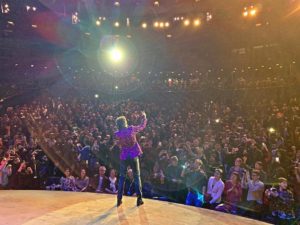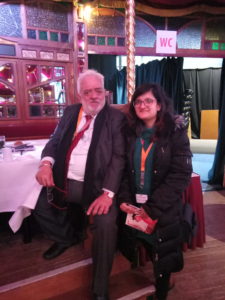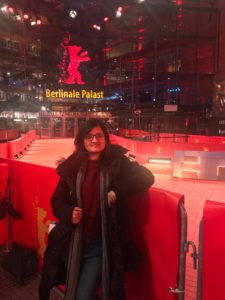I applied to the MA International Film Business course with the aim of learning more about how the cinema of my country is received in the international market and how I could contribute to making it even better. Attending the Berlinale was a dream in which I would get to meet professionals from the Indian film industry and get first hand insight on what it takes to represent the country with the largest output in terms of number of films in the world. Well, India’s presence at Berlin International Film Festival 2019 was much better than previous years but slightly underwhelming.

I get reminded of a dialog from the marvelous 3 Idiots, “Don’t forget, har saal ICE mein chaar laakh se bhi zyada applications aati hain, aur sirf 200 select hoti hain. You!” (Don’t forget, ICE receives more than 400,000 applications each year, and only 200 get in. You!) The competition is fierce in every arena, and so in films. Each year India produces more than 1,500 films. An industry with a box office earning of US $2 billion+, very few Indian films reach the global audiences. I am not talking about the big-budget Bollywood flicks that are made for the diasporic audiences. There are many gems in the industries from other regions of India, ones that stir your emotions and blow your minds with their technical finesse, are loved but eventually forgotten because they don’t get the reach they deserve. Berlinale 2019 reflected a similar scenario, when only 8 Indian productions/co-productions were selected to be screened in the different sections of the festival. But don’t think that this is a sad report of India’s under-performance at the festival, because the 8 films that were selected reflect the much needed and observed change in our cinema and only indicates the positive direction in which our cinema is headed.
The Indian films at Berlinale this year were some of the best Indian films I have seen since I started caring about films. The selections comprised of Zoya Akhtar’s Gully Boy (Berlinale Special gala), Ritesh Batra’s Photograph (Berlinale Special Gala), Prantik Basu’s Rang Mahal (Berlinale Shorts Competition), Udita Bhargava’s Dust (Perspektive Deutsches Kino), Rima Das’ Bulbul Can Sing (Generation 14 Plus), Ritu Sarin and Tenzing Sonam’s Shadow Circus (Forum Expanded), Ruchir Joshi’s Tales from Planet Kolkata/Egaro Mile (Archival Constellations), and an episode from Netflix’s Chef’s Table – Asma Khan (Culinary Cinema). Most of these were international co-productions, primarily with Germany which has actively co-produced many Indian films in the past.
Let’s talk about the phenomenon of “Big-Budget” Bollywood dramas that are highly commercial and characteristically, used to adhere to the stereotypical tropes of the Indian high society. I could say that these films presented to the masses a world they would aspire to be in, very different from their own, affluent and dramatic – with exquisite designer costumes and elaborate “fancy” sets, big stars and lots of song and dance. A lot has changed since then. The Indian audiences were probably tired of looking at the “richness” and wanted more relatable content, 2018 cinema and the box office was a proof of that. Zoya Akhtar’s Gully Boy delivered exactly that, and more. A “big-Budget” Bollywood film by an established filmmaker, Gully Boy is set in Mumbai’s Dharavi area, one of Asia’s largest slums, loosely based on the lives of street rappers Divine and Naezy. (Variety, 13 February 2019) The film took its audience into the heart of the slum and into the “khopcha” (tiny corner) of the common slum dweller Murad. It followed Murad’s journey to fame via the underground dungeons and rap battles and through the streets of crime and poverty. It was relatable and it presented something new – the street rap scene got placed on the map with Gully Boy. The grand gala premiere and high energy performance by the lead Ranveer Singh for the house-full Friedrichstrasse Palast, gave the berlin audience a taste of a local Mumbai single screen theatre where the entire audience laughed, cried and sang along throughout the film. According to Cameron Bailey, Artistic Director, Toronto International Film Festival, a regular at the Berlinale, “Gully Boy” elicited the “biggest cheers” he had heard in “20+ years at the Berlinale.” (News18.com)

Ritesh Batra’s Photograph (Co-production between India-Germany-USA), is a quiet, slice of life film about street photographer Rafi who meets young Miloni, from India’s up-and-coming middle class. Their unusual love story that has to surmount class boundaries, beautifully takes the audience on a journey through Indian society. The very quiet, slow paced film takes the audience through the lives of the upper- and lower-class Indians, the differences and commonalities of their aspirations and the boundaries that they dare not cross.
Udita Bhargava’s Dust (co-production between Germany and India) follows a man who retraces the footsteps of his lost love. His journey takes him into the troubled heart of India and inexorably leads to a confrontation with the past. The way in which past and present had been woven together in this film was exceptional, and the fact that it was shot near my hometown made me ecstatic and surprised, because no one in India is speaking about this film as much as they should, and most people don’t even know about this film. Dust was hands-down my favorite film at Berlinale.
I cannot not talk about Rima Das’ Bulbul Can Sing. Das’ previous film Village Rockstars was India’s official submission for the Oscars, and Bulbul can Sing is no less worthy of that honor. Portrayed in snapshots of school and country life, a summer of youthful innocence comes to an end for three friends. Faced with loss and passion, Bulbul finds her voice. In reaction to her oppressive patriarchal rural community, she sings her own song. The film beautifully shows the dull lives of school kids living in the vibrant countryside, and the best part was that all departments of the films crew were solely helmed by the creator Rima Das.

These were the films that I could catch during my very short visit to the festival and a very packed schedule, but I am sure, the other films from India were as diverse and vibrant as the country itself. We can see that Indian films are much more than just song and dance and we presented that very well at the festival, just not enough in quantity.

The India Pavilion at the European Film Market was promoting India as a unique production location aided by the diverse landscape and extremely feasible exchange rates that makes production in India very cost-effective. Despite the benefits, there were no major deals signed. The Indian contingent promoted the latest policy of single window clearance for filmmakers that eases the process of shooting in India and the newly launched accessible website for applications. They invited filmmakers for the Golden Jubilee Year of International Film Festival of India (IFFI), Goa in November 2019.
The Indian representation at Berlinale Talents was phenomenal this year. We had 9 participants from different fields of the Indian film Industry presenting and honing their talents at Berlinale Talents. Prantik Basu, a Talents participant also had his short film “Rang Mahal” in competition as well.
India lacks due to the diminished interest of the Indian Government in facilitating the Entertainment Industry. There are no Tax Credits for Indian Filmmakers and there lies a tremendous lack of public finance to develop and produce films in India. Almost all films that are made in India are funded privately by corporates and individuals. The National Film Development Corporation (NFDC), established in 1975 has till date developed or produced only over 300 films (remember India produces 1500+ films each year). There are systems in place like the NFDC’s Film Bazaar – a co-production and distribution market for the South Asian region alongside the International Film Festival of India, Goa, and “Cinemas of India”, a label specifically to promote and distribute the parallel cinema film produced by it, since the 1960s. However, these schemes aren’t promoted well enough to attract filmmakers or are too complicated to get through.
I discussed these issues during my chat with veteran filmmaker Rahul Rawail at the India Networking Event and later at the India Pavilion at EFM, and he said that the need of the hour is to engage into talks with the Ministry to get more involvement and showing proactivity in promoting these facilities. “The Government does not wish to invest more public funds into films as India is a huge country and expenses like defense and infrastructure are prioritized over entertainment. Moreover, given the condition of currency exchange rates, having an additional tax credit for filmmaking would probably make production almost free of cost which is unhelpful to the economy” said Rawail. However, he was eager to get in conversation with the Ministry and hopefully, in the coming years, the government might show more interest in the entertainment sector.

I went to the festival with the purpose of mapping the presence of my country and I can say that I made the most out of my time there. Personally, the hardest part seemed to be the networking that we had to do. Being an introvert doesn’t really help in this industry and I had to break out of my shell to reach out to people. I did miss out on connecting with people during the market or at parties, that I always avoid and that wasn’t a wise decision at all. I did eventually let go of my hesitation and reached out to people. I did make some useful contacts for example, I connected with the Creative director of the Mumbai International Film Festival. By the end of the week in Berlinale, I was really satisfied with the connections I could make. For a person from a non-film background or an introvert like me, I think it is really important to realize the value of conversations with random strangers who might turn out to be the most valuable contact in the industry. People at festivals like Berlinale are easier to approach and speak to, they won’t turn you away unless they’re very busy and there’s still the opportunity to drop your business card and ask for theirs to be able to connect later on. I think this was the most valuable takeaway for me.
I also took out time to explore the iconic, historic city of Berlin with its spectacular monuments and museums. Taking a day off amongst the very hectic festival schedule is important too, because you cannot come to Berlin and just leave without taking in the city in all its glory (the entire city is a giant photo-op, no matter where you go), enjoying the weather which was surprisingly not as cold as it was supposed to be (we even got really sunny days), and enjoying the variety of food at all the unique restaurants, especially around Potsdamer Platz. Berlinale was such an enriching experience.


